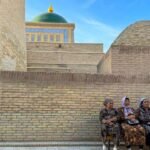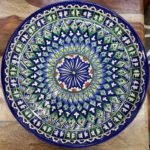AL BUKHARI tour Uzbekistan – Muslim tour to Uzbekistan 2024 – 2025
Muslim pilgrimage tour to Uzbekistan consists of visits to the sacred places of Uzbekistan. First, you will visit the spiritual center of Tashkent – Khast Imam Square.
There is one of the oldest copies of the Holy Quran – the Quran of Osman (VIII century). You will also have the opportunity to visit the shrines of Samarkand – Shahi Zinda, the Mausoleum of Amir Temur where is also buried his spiritual mentor Mir Said Baraka.
The great Al Bukhari is also buried in Samarkand. He compiled the hadith collection known as Sahih al-Bukhari, regarded by Sunni Muslims as the most authentic (sahih) hadith collections. The Mausoleum of Imam Al-Bukhari is one of the most revered Islamic shrines in Central Asia.

Itinerary of tour – Muslim pilgrimage tour to Uzbekistan:
1 DAY
HOME – TASHKENT (flight + excursion)
Arrival in Tashkent (If you are arriving by an early morning flight, extra night at the hotel may be needed). Meet guide of your group, transfer to hotel (10 km).
Breakfast. Check in at 13:00.
Time for rest.
Excursion in the city visiting:
‘Khasti-Imom’ complex: madrassa, mosque, mausoleum & museum of the Holy Koran. Mausoleum of Kaffol Shoshiy (903-976), he was very famous and holy scientist in Tashkent in his time. He named ‘Khasti Imom’ by people. Madrassa of Barakkhan (XVI cen.), was one of the most popular Koranik school, today is center of craftmen. Museum of Moyi Mubarek is very interesting sacred place, where Holy Koran – Osman’s Koran (VII cen.) & ancient manuscripts (XIII-XX cen.) are kept. Mosque Tilla Sheikh (1890 y.) is functioning mosque, where Muslims pray five times a day. Friday Mosque of Khazrati Imom (was built in XIX century & named as Namozgokh Friday Mosque) is biggest mosque, which is rebuilt in 2007. Every Friday this place is filled with Muslims.
Overnight in the hotel.
MEALS: B/-/D
2 DAY TASHKENT – SAMARKAND (train + excursion)
Breakfast. “Check out” hotel.
At 06:30 transfer to the train station. Transfer to Samarkand by high-speed train “Afrosiyob” 07:30-09:40.
On arrival excursion The Mausoleum of Gur Amir is Persian for “Tomb of the King”. This architectural complex with its azure dome contains the tombs of Tamerlane, his sons Shakhrukh, Miranshakh and grandsons Ulugbek, Sultan Muhammad. Also honored with a place in the tomb is Timur’s teacher Sayyid Baraka.
The Registan Square was the heart of the ancient city of Samarkand of the Timurid’s dinasty. It is framed by three madrassas of distinctive Islamic architecture: the three madrassas of the Registan are: The Ulugbek Madrassah (1417–1420), The Tilla-Kori Madrassah (1646–1660) and The Sher-Dor Madrassah (1619–1636).
The Mosque Bibi Khanum is one of the most important monuments of Samarkand. In the XV century it was one of the largest and most magnificent mosques in the Islamic world. The mosque was built using wealth looted during his conquest of India.
The Mausoleum of Shah-i-Zinda (means “The Living King”) is a necropolis in the north-eastern part of Samarkand. The Shah-i-Zinda Ensemble includes mausoleums and other ritual buildings of IX-XIV and XIX centuries.
The Ulugbek’s Observatory was built in the XV century by the Timurid astronomer Ulugbek, it is considered by scholars as one of the finest observatories in the Islamic world in that century. Some of the famous Islamic astronomers who worked at the observatory include Al-Kashi, Ali Qushchi and Ulugbek himself. The observatory was destroyed in 1449 and rediscovered in 1908.
Overnight in the hotel.
MEALS: B/-/D
3 DAY SAMARKAND – BUKHARA (260 km + excursion)
Breakfast.
In Samarkand region visit to the tomb of Imam al-Moturidi is another sacred place in Samarkand. The grand Imam and famous philosopher and theologian fought for the purity of Islam. He was buried there in 944, in the cemetery Chokardiza where many other famous scientists of Islam world were buried as well. Once upon a time a military fortress was here, therefore the cemetery has such a name: “Chokar” means “army” “Disa” means a fortress.
In Samarkand region visit to the complex of Imam Al-Bukhari. The Mausoleum of Imam Al-Bukhari is one of the most revered Islamic shrines in Central Asia. He authored the hadith collection known as Sahih al-Bukhari, regarded by Sunni Muslims as the most authentic (sahih) hadith collections.
Departure for Bukhara (260 km).
On arrival free time.
Overnight in the hotel.
MEALS: B/-/D
4 DAY BUKHARA (excursion)
Breakfast.
Excursion in the historic center of Bukhara.
The mausoleum of Samanids is located in the historical urban nucleus of the city of Bukhara, in a park laid out on the site of an ancient cemetery. This mausoleum, which is one of the most esteemed sights of Central Asian architecture, was built in the IX (X) century (between 892 and 943) as the resting-place of Ismail Samani – a powerful and influential amir of the Samanid dinasty, one of the Persian dynasties that ruled in Central Asia, who held the city in the IX and X centuries.
Mausoleum of Chashma-i Ayub is located near the Samani Mausoleum. Its name means Job’s well, due to the legend in which Job (Ayub) visited this place and made a well by striking the ground with his staff. The water of this well is still pure and is considered healing. The current building was constructed during the reign of Timur and features a Khwarazm-style conical dome uncommon in Bukhara.
The Mosque of Bolo Khauz issituated opposite to The Ark, where the emirs worshiped. It was built in 1718 with a roof extension supported by karagachi (a rare sycamore-like wood) pillars in the XIX century. The west side is reflected in the XVI century khauz (pool). Most mosques in Bukhara have pools attached to them.
The Ark of Bukhara is a massive fortress located in the city of Bukhara, that was initially built and occupied around the V century AC. In addition to being a military structure, the Ark encompassed what was essentially a town, during much of the fortress’ history, it was inhabited by the various royal courts that held sway over the region surrounding Bukhara. The Ark was used as a fortress until 1920.
The square of Poi Kalyan (means “The Foot of the Great”), is an Islamic religious complex located around the Grand Minaret – Minorai Kalon.
Taqi Sarrafon – bazar of the moneychangers, Taqi-Telpak Furushon – bazar of the cap makers, Taqi-Zaragon – bazar of the jewelers.
The Mosque of Magoki Attori was constructed on the remains of an older Zoroastrian temple. It was destroyed and rebuilt more than once, and the oldest part now remaining is the south facade, which dates from the XII century, one of the oldest surviving structures in Bukhara.
The Lab-i Hauz Ensemble (meaning by the pond 1568–1622) is the name of the area surrounding one of the few remaining hauz (ponds) in the city of Bukhara. The Lab-i Hauz Ensemble, surrounding the pond on three sides, consists of the Kukeldash Madrassa (1568–1569), the largest in the city, and of two religious edifices built by Nadir Divan-Beghi: khanaka (1620) or lodging-house for itinerant Sufis and madrassah (1622) that stand on the west and east sides of the pond respectively.
Overnight in the hotel.
MEALS: B/-/D
5 DAY BUKHARA – TASHKENT (excurtion + TRAIN)
Breakfast. Check out hotel.
Visit Bakhouddin Naqshbandi Mausoleum (10 km from Bukhara) – muslims from different Muslim countries come here to ask for the fulfillment of desires and the aversion of sins.
Sitorai Mokhi-Khosa (XIX century mid) – summer residence of Bukhara’s last emir. The Bukhara architects having trained in Russia managed to combine oriental and western styles in their creation.
Chor Bakr Necropolis (XVI century) – is really an unusual and mysterious place. Visiting Chor-Bakr you could not help but feel the breath of the world of the dead, where in the quiet of the alleys the thoughts of the frailty of life and the transience of human life unwittingly come into your head.
Transfer to railway station and departure for Tashkent by train Afrosiab 15:50-19:44.
Overnight in the hotel.
MEALS: B/-/D
6 DAY TASHKENT – HOME (10 km + flight)
Early morning, transfer from hotel to airport & departure to home.
MEALS: B/-/-
THE TOUR INCLUDE THE FOLLOWING SERVICES:
- VISA SUPPORT Letter (Letter of invitation) for Uzbek visa;
- A/C transfers (car/minivan/bus), all airport transfers as per the program;
- Professional (English speaking) guide during tour;
- Entrance tickets to museums and historical monuments;
- Accommodation in the hotels on TWIN/DBL sharing rooms;
- Half board meal plan (breakfasts and dinners);
- Train Tashkent/Samarkand and Bukhara/Tashkent. In order to get train tickets on time, we strongly ask you to send a list of tourists with passport data 40 – 30 days before the start of the tour;
- 1 T/L free of charge in SGL room including all services as per program FROM 16 PAX.






